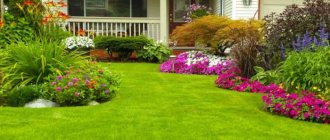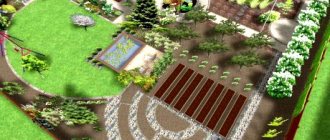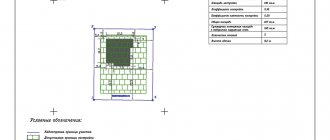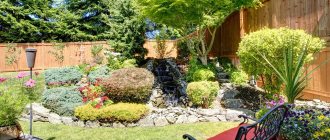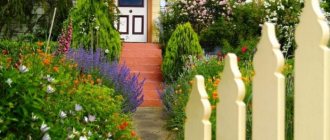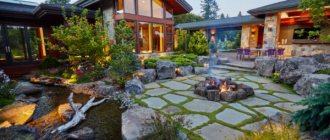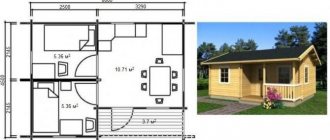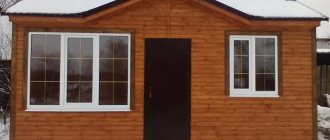To make the garden plot beautiful, you need to outline in advance where the buildings and plantings will be. The layout of the garden plot and vegetable garden is very important. This determines how the site as a whole will look and how convenient it will be to use the buildings, small architectural forms and plantings. The article describes how to draw up a garden plan, taking into account the characteristics of the site.
Garden plot plan for 2 adults and a dog.
Design and proper layout of a vegetable garden for planting
A vegetable garden can look almost as beautiful as flower beds. Now it has become fashionable to design a vegetable garden not in the form of traditional long beds, but in French, English styles and in the form of flower beds. After all, garden crops look very decorative.
The vegetable garden usually occupies about 30% of the entire area of the site. The vegetable garden is usually allocated a place at the rear border of the plot. Low ornamental shrubs can be planted between the garden and the rest of the area.
Basic conditions for a vegetable garden:
- water source nearby;
- lack of shadow from a fence or tall trees.
Location of beds for vegetable crops
The beds should be positioned north to south to receive maximum sunlight during the day. Make the width of each bed no more than 70 cm. Then you can easily reach its middle. We arrange passages between the beds more than 40 cm so that a garden cart can pass through them.
Before planting the beds with vegetable crops, carry out preliminary preparations:
- Make a planting plan. This is necessary in order to fit all the plants, as well as to subsequently implement correct crop rotation.
- Distribute the plants in the beds so that the taller ones are in the center and the shorter ones are at the edges of the plantings.
Vegetable planting scheme, crop rotation, description
Plant vegetables according to the plan drawn up in advance. This scheme should take into account crop rotation and the compatibility of various garden crops.
Since different plants consume nutrients differently, taking them from the soil, the planting locations of these plants are changed every year. This is called crop rotation. In addition, by changing the place where vegetables are planted, we fight unwanted diseases. It is advisable to return plants to one place no earlier than after 3 years. During this time, the earth will replenish the spent useful elements and be freed from pathogens.
To properly carry out crop rotation, divide the entire garden into several parts. It is most convenient when there are four such parts.
- Leafy crops: lettuce, cabbage, green onions, spinach, etc.
- Fruit crops: tomatoes, cucumbers, peppers, zucchini, eggplants, pumpkins, etc.
- Root vegetables: carrots, potatoes, beets, radishes, etc.
- Legumes: peas, beans, lentils, chickpeas, etc.
Scheme of planting plants in the garden in the first year.
If in the first year the plants are planted in the order shown in the diagram, then in the second year the plantings change.
You can combine beds differently:
The second option for forming crop rotation in the garden.
In certain areas, plants are arranged as follows:
- Pumpkin, cucumbers, squash, zucchini, cabbage.
- Potato.
- Radish, beets, carrots, root parsley.
- Tomatoes, peppers, radishes, garlic, onions.
The next year, swap the plantings, moving them clockwise, and so on every year.
You can create your own planting patterns in accordance with the following table:
| Culture | Friends with... | Enmity with... |
| Potato | Peas, radish, beets, horseradish, eggplant, lettuce, dill, beans, corn, garlic, onion, parsley | Cucumbers, tomatoes, fennel, celery |
| Tomato | Cabbage, onions, asparagus, beans, mint | Potatoes, cabbage, fennel, cucumbers, peppers |
| Eggplant | Peas, beans, potatoes, legumes | Fennel, onion, garlic |
| Cabbage | Potatoes, onions, lettuce, beets, celery, dill | Beans, tomatoes, fennel |
| Carrot | Peas, onions, tomatoes, rosemary | Celery, fennel |
| cucumbers | Peas, cabbage, beans, lettuce, dill | Pepper, tomato |
| Beet | Onions, cabbage | Beans, mustard |
| Melon, pumpkin | Corn, radish | Potato |
| Peas | Eggplant, radish, potatoes, carrots, cucumber, beans, corn | Onions, garlic, tomatoes, fennel |
Some vegetable crops are perennials. These include:
- sorrel;
- rhubarb;
- tarragon;
- some varieties of onions;
- lovage;
- asparagus.
They can be planted separately, in a specially designated area.
Summer residents often practice the method of small crop rotation, when several crops are grown in one place during the season. This method is justified when there is little space on the site for a vegetable garden. If there is enough space, then after harvesting early ripening crops, it is better to plant green manure in their place.
On the slope
Sites on a slope are considered not very successful, although from the point of view of landscape designers, this is simply a godsend: the landscape changing in height looks attractive, and the created multi-level terraces make it possible to zone the garden space not only along the surface of the ground, but also in height.
However, a sloped area has the following disadvantages:
- the fertile layer is washed off;
- water is poorly retained;
- the wind dries the ground very much.
Therefore, for a site on a slope it is necessary to provide terraces. This is a labor-intensive undertaking, but there is no other way.
You can do without terraces only when the slope of the site does not exceed 10%. In this case, the slope can be strengthened by planting plants with a highly branched root system on it:
- broom;
- elder;
- barberry;
- quince;
- juniper;
- periwinkle.
To create terraces, you can use retaining walls, gabions or geogrids. For a vegetable garden, high beds are an excellent option on a site with a slope.
Terracing formed on a site on a slope.
For safe movement around the site, steps must be provided. Such steps can be made of boards, concrete, paving slabs or simple logs. The width of the stairs should not be less than 60 cm. Along the length, the steps must be interspersed with level platforms. You can place benches and flower pots on the platforms. Illuminated steps look very original.
Small vegetable garden 1–2 acres
The problem often arises: how to place all the necessary vegetables in a small area? Here are a few tricks that will save space in your garden.
- Compacted plantings. To save space, you can do some plantings very close to each other: plant onions and garlic between the rows of strawberries, cabbage - between the rows of potatoes, and tomatoes - near the currants (it will be easy to tie up the tomatoes and there will be fewer pests on the currants).
- Let climbing plants run along the trellises. Climbing plants such as cucumbers, pumpkins, melons, watermelons, and peas take up a lot of space. It makes sense to make special trellises or pergolas for them. Then you can save space. When the fruits become heavy, they can be placed in a string bag hanging from a trellis.
- Multi-tiered plantings. The principle of such a garden is that the beds are arranged vertically. To do this, you can hang plastic bags from a vertical support and fill them with fertile soil, or use a hollow post placed vertically and also filled with black soil as a bed. This method is convenient for growing strawberries and herbs. Multi-tiered beds can be made by stacking several wooden boxes on top of each other.
For a small garden it would be appropriate to grow only rare plants. So you can buy carrots and beets in the store, since these vegetables are not expensive, and you can grow cherry tomatoes, cucumbers, eggplants, asparagus and sweet potatoes in your garden.
A garden of 1 acre in size, properly organized, will provide a family of four with all the necessary vegetables to eat in the summer and will allow them to make preparations for the winter.
Small vegetable garden 3–4 acres
A vegetable garden laid out on 3–4 acres is optimal for growing garden crops. On the one hand, there is enough space to grow all the necessary vegetables, and on the other hand, you don’t have to work too hard to process it.
The principle of setting up such a vegetable garden is also based on organizing proper crop rotation. This means that the garden is divided into 4 sections and plantings on them alternate in a certain order.
Vegetable garden 20 acres in the village
A large plot of 20 acres, given over to a vegetable garden, will require large resources in terms of maintenance. Typically, such a plot is cultivated by several families. It is also recommended to divide such a vegetable garden into several sections to ensure proper crop rotation.
If you have a large garden, you can sow part of it with green manure to give the soil a rest, and next year you can grow vegetable crops in this part. Sow the same part on which the vegetables grew with green manure.
English vegetable garden
A vegetable garden, which can be mistaken for a flower bed, it is so decorative, was borrowed from England and is called English. In England, for a long time, small vegetable gardens have been planted at home, which look very beautiful and bring a large harvest. In England, gardening is mostly done by men. They are very proud of their plantings. Such a vegetable garden is the owner’s calling card.
Beds in an English vegetable garden do not always have a rectangular shape. They can be in the form of a round flower bed, in the form of a spiral or any other shape. Vegetables are planted parallel to the edges and follow the shape of the bed. Garden crops can be combined with flowers, which gives the beds an elegant blooming look.
The English vegetable garden does not have the symmetry that is characteristic of the French vegetable garden. The main thing here is to arrange the crops so that the garden bed looks like a flower bed.
And one more touch of the English vegetable garden - here much attention is paid to paths. They are very wide and occupy most of the site.
An example of the arrangement of plants in an English vegetable garden.
Plan of a rectangular vegetable garden
A rectangular plot for a vegetable garden does not pose any problem. It is enough to divide it into 4 zones and plant plants according to the crop rotation given in the section “Vegetable planting scheme, crop rotation, description.”
Rectangular vegetable garden.
If you are not satisfied with rectangular beds because of their boring shape, you can always place the beds of a French or English vegetable garden on a rectangular plot.
An example of the arrangement of plants in a French garden.
To be very beautiful
To give your garden an attractive look, just follow the following rules taken from garden design:
- For single plantings, it is worth thinking about the design of the background. High crops are suitable for it: corn, amaranth, Jerusalem artichoke, herbs.
- To add additional volume and height to the garden, you can use pergolas and trellises for climbing plants such as cucumbers, beans, peas, and pumpkins.
- To add color to the garden, you can place nasturtium and calendula.
- Marigolds, parsley, lettuce, radishes, carrots, and basil will look good as a border for a garden bed.
By laying out a vegetable garden in the form of beds of a non-standard shape and decorating it with flowering plants, you can get a decorative corner of the garden.
According to Mittleider
A vegetable garden organized according to the Mitlider method takes up very little space and produces a good harvest. The method is based on creating narrow beds and balanced nutrition for plants based on mineral fertilizers.
Before organizing your garden, dig it up thoroughly and free it from weed roots. It is necessary to fulfill 3 necessary conditions to obtain a good harvest using the Mitlider method:
- Strictly follow the recommended sizes of beds and aisles.
- Stick to a specific planting pattern.
- Observe the correct regime of watering and fertilizing garden crops.
We choose the width of the beds to be 45 cm, the length can be any. Along the edge of the bed we make small earthen mounds about 10 cm high. The width of the passages should be 105 cm.
We plant seeds or seedlings along the sides in 2 rows. Before planting, we add fertilizer to the ground: 100 grams per linear meter of a mixture consisting of 5 kg of dolomite flour and 40 grams of boric acid, as well as macro and microelements. We fertilize once a week with a mixture of macro and microelements. We do not loosen the beds so as not to damage the root system of the plants.
Layout of paths on a summer cottage
Convenient paved paths allow easy access to any area of the site, even in rainy weather, and keep the house clean. A site with beautiful paths looks attractive and respectable.
Paving paths is an expensive endeavor. You need to seriously think through the plan of paths in advance, so that later you do not experience disappointment from inconveniently laid out routes.
When drawing up a plan for paths on the site, be guided primarily by ease of movement. The cart should pass freely along the path and the path should be as short as possible.
On the other hand, in accordance with the rules of garden design, the paths must correspond to the style of the site: if a regular style is chosen for the site, it is better to make the paths straight. If the garden design has a landscape style, then the paths should be made in the same style: be winding. Alternatively, the main path can be made straight, and the secondary paths can be winding.
The main routes of movement on the site are often the following routes:
- from the entrance to the site to the house;
- from the parking lot or garage to the house;
- from home to garden;
- from the garden to the well;
- from the garden to the compost heap;
- from house to barn;
- from the house to the gazebo or recreation area.
It is enough to mark these routes on the plan with arrows to visualize all possible movements.
Necessary routes for movement around the site.
The most beautiful is the main entrance path from the gate to the house. The material here can be paving slabs or natural stone. It can have a beautiful curved shape and should be wide enough.
Paths that have an economic purpose - leading from the garden to the well or compost - are best made straight, with a durable simple coating: asphalt, concrete or artificial stone. The width of such paths should be sufficient for the passage of a garden cart: from 40 cm to 1 m.
Walking paths leading from the house to the gazebo or recreation area may have a winding shape. They can be made of wood, mosaic slabs. They can be covered with pebbles or tree bark.
Read about how to decorate paths with a living border in the article “What to plant along the path in the country to make it beautiful.”
Why sprinkle sawdust or leaves (chips) on top?
Sprinkling sawdust on top of the soil is called mulching. This procedure not only helps the tree retain moisture, but also prevents the formation of an unpleasant crust on top of the soil.
It is also very important not to bury the root collar when planting. But you shouldn’t expose it too much either, and therefore all holes for fruit plants are prepared in advance so that after the soil settles, the planting depth does not change.
Layout of flower beds
Before arranging flower beds, you need to put them on the general plan of the site. Flower beds can occupy the entire territory of the site that remains free after building a house, laying out a garden, constructing utility buildings and small architectural forms, such as a gazebo.
Flower beds can be made in the form of:
- flower beds;
- discounts;
- mixborder;
- rosary;
- curb;
- rockery;
- stalls
Flower beds can have the correct shape of a circle, rectangle or square with a regular layout of the site and an irregular shape in the form of a drop, a trapezoid with curved edges or another shape with a landscape style. For flower beds, choose an open sunny place. Both perennial and annual flowers are planted in flower beds.
Borders and ridges are arranged along the edges of the path, around the gazebo or veranda. They are long narrow flower beds ranging from 40 cm to 2 m wide and of arbitrary length. The sizes of flowers in discounts and borders are selected depending on their width. The narrower the border or border, the smaller the flowers on it.
There are special plants designed for planting on borders and ridges, for example, border chamomile. Flowers here can be selected in several varieties or limited to one type. Borders can be used to zone space on a site.
Complex compositions such as rose gardens and mixborders require special care. Mixborder is a planting of perennials, planted in tiers. A beautiful mixborder is the result of considerable work and perfectly decorates the site.
The rose garden also requires special care and serves as the highest testament to the gardening skills of the owners. It consists of roses of one or more species. The rose garden is located in the most prominent place in the center of the site.
Rose garden.
A rockery is set up in an open area using miniature plants and stones. It is also called a rock garden. Rock gardens use plants that do not require special care, but the design of the rock garden itself involves the use of certain skills and knowledge in the field of gardening.
Parterres made from perennials are usually used in regular layouts. The ground floor consists of various geometric shapes of flowers on the lawn. The placement of flowers can be plain without a pattern or with a pattern.
You can place just one flower bed on the site or as many as can fit. A flowerbed or rose garden is usually placed near the main entrance. Edges and borders are arranged along the paths and around the gazebo.
Basic landing rules
The bottom of the hole should be filled with three layers in the following sequence: first a layer of expanded clay, then a layer with last year’s leaves and a layer of wood ash.
Place the seedling on the resulting three layers and straighten the roots a little, then immediately add a bucket of compost or the same amount of humus and shake the plant slightly so that the roots are better straightened and the soil settles a little.
Press the soil lightly and water it with two buckets of water at once.
Only after the hole has completely absorbed water can you add more good fertilizer and mulch the circle with leaves, rotted sawdust or wood chips.
Orchard layout
When planning a garden, you need to consider the following points:
- Fruit trees should not cover decorative plantings, which means they should not be located between the house and decorative plantings.
- The garden should not block the view from the windows of the playground house.
Fruit trees do not need to be planted in a separate area, but rather distributed throughout the area.
Plant garden trees at a distance equal to at least half the diameter of the crown from the border with the neighboring plot. This is necessary so that the crown does not overhang someone else’s territory.
Proper care for young people
There is nothing more important than watering for a young tree. Therefore, it is initially worth organizing the correct watering regime. Watering is also important for those plants that were planted in the autumn. They should be watered generously until the first frost.
The next and no less important rule for caring for young seedlings is disease prevention and, accordingly, protection from pests.
All these manipulations are so important for the simple reason that in the first winter it will be very difficult for a fragile plant to cope with such loads on its own.
Whitewashing and wrapping the trunk in plastic bottles or car tires will help protect the plant from rodents.
The most interesting thing is that frost-resistant varieties can freeze slightly in the first years of replanting, and therefore, for their safety, it is worth doing a little insulation with spruce branches.
Another important rule is the first flowering. Yes, it is very beautiful and yes, gardeners were really looking forward to it. But it’s still worth thinking about the future and gaining willpower and simply cutting off all the flowering - at this time it is important that the tree spends energy on growth and development, and not on flowering and ripening the crop. It must first strengthen itself.
Layout of garden trees and shrubs on the site
After choosing a place for the garden, you can begin to determine the number of fruit trees and shrubs and select specific varieties. To do this, you need to draw up a plan for planting garden plants on the site. When drawing up a plan, we are guided by the following questions:
- The possibility of trees planted nearby pollinating each other.
- Selection of crops with different fruit ripening periods.
- The need for some crops to have a male plant (sea buckthorn, actinidia, lemongrass).
- Taller trees should not obscure lower ones.
Sometimes fruit plants are planted around the perimeter of the site. In this case, shrubs are planted no closer than 1.5 m to the fence, cherries and plums - no closer than 3 m, apple and pear trees - 4 m. If trees are planted in rows, then the distance between them should be 5-6 m.
To satisfy the needs of an average family, it is enough to plant 1-2 trees of each type. We recommend having in the garden:
- cherries - 2 pcs.;
- cherries - 2 pcs.;
- quince - 1 pc.;
- plum - 2 pcs.;
- apricots - 2 pcs.
When planning a berry garden, bushes can also be planted along the perimeter of the site or a separate area can be allocated for it. The distance between fruit bushes should be:
- raspberries - 0.5 m between bushes in a row and 1.5 m between rows;
- yoshta, black and golden currants - 1.5 m between bushes;
- red currant - 1 m between bushes;
- honeysuckle, irga - 2 m between bushes.
When calculating the required number of shrubs for a family of 4–5 people, focus on the following figures:
- raspberries - 20 bushes;
- currants - 3 bushes;
- gooseberries - 3 bushes.
The berry garden is left in one place for 7–12 years. Then the plantings are moved to a new location.
How to preserve seedlings before planting
Gardeners often purchase seedlings long before planting. In this case, the question of how to preserve purchased seedlings before planting in the ground becomes relevant. In fact, there is nothing complicated about it.
To protect the roots from drying out, wrap them in damp rags and then place the seedlings in a dark and cool place. Make sure that the rhizome of the seedling does not dry out!
When transporting plants, it is recommended to wrap the roots and branches with a soft cloth. It is advisable to transport seedlings inside a car or in a trailer covered with a thick tarpaulin.
In order for the seedlings to quickly take root and grow well, they need to be prepared for planting. To do this, trim the roots to healthy tissue, and remove thin and dried roots.
2-3 hours before planting, water the roots of the seedlings generously if the plant is in a container, or immerse it in water if the rhizome is open. This procedure helps to moisturize the roots and improve survival.
Plants from containers are planted together with the mother earthen ball. Certain types of shrubs and trees require significant pre-planting pruning of shoots.
Rose garden layout
The rose garden is usually the “signature of the site.” The rose garden is arranged in the most prominent place in the form of a flower bed of regular shapes: rectangle, circle, in a regular garden style. For a garden in a landscape style, a rose garden is arranged in the form of a free-form flower bed. Paths are laid around the rose garden or a lawn is sown. A rose garden illuminated in the evening looks very impressive. You can place a small pond near the rose garden in landscape style.
The rose garden should be planted with roses of various varieties that combine well with each other. Roses are planted in groups, 4–5 bushes each.
Rose garden in the garden plot.
When arranging a rose garden, it is better to play with color contrasts. At the same time, plants of the same color are planted together. Roses, the flowers of which are painted in several colors, are planted separately. Other flowers that look good together with roses can grow in the rose garden: clematis, daisies.
You may be interested in: “What flowers to plant in the flowerbed so that they match each other in color and height.”
Layout of recreation areas with gazebos
It is very important to have a recreation area on the site. It can be quite small and consist of a small bench. But if you approach its design creatively, then any bench can turn into a powerful source for restoring strength after a hard day.
A garden gazebo can become a central place for relaxation in a country house or on a personal plot, if you choose the right place for it and arrange it. Don't design the gazebo as a place to eat. It is more suitable for solitude after lunch or for tea. It is worth considering it as a place to relax.
It is better to place the gazebo on an elevated place. In order for your stay in the gazebo to be relaxing and truly comfortable, you should take care of its correct location and some arrangement. The following 5 items will turn your gazebo into a real paradise.
- Long shot. It will be great if your gazebo offers a view of some natural space: a lake or pond, a flower meadow, a forest edge.
- Close-up. Plant your favorite flowers next to the gazebo so you can admire them in close proximity.
- Aroma. Your vacation will become even more enjoyable if you enhance the feeling of comfort and peace with a pleasant scent. To do this, plant flowers with a light aroma next to the gazebo: sweet peas, lilies or roses.
- Home comfort. Decorate the gazebo with light curtains and matching sofa cushions. Sitting will be much more comfortable and the overall appearance will be more pleasant.
- Backlight. As dusk approaches, turn on the lighting. This will give the relaxation corner a special charm. Lamps can be the simplest. You can simply place candles in the gazebo.
There is no doubt that a gazebo or recreation area arranged in this way, consisting of even one bench, will attract all members of your family.
Site layout with features
Some garden plots have features that can be considered as disadvantages, or can be turned into advantages.
With a slope
An area with a slope of less than 10% can be used in the same way as a flat area. Such a small slope does not require special solutions. If the slope is more than 10%, then you need to divide it into separate terraces with retaining walls. Inside each terrace, the soil should be leveled and a level area should be created.
A plot with a slope, divided into terraces, makes it possible to organize several completely isolated zones located at different heights: a recreation area, a vegetable garden, a children's playground, a prairie garden. It's beautiful and convenient. Stairs also add a special touch to this garden.
Thus, the entire site will be divided into separate zones located at different heights. Each zone can be used differently:
- as a recreation area;
- as a children's playground;
- like an orchard;
- like a vegetable garden;
- as a garden area made in a certain style: English garden, prairie garden.
Connect each zone with other zones with steps or a common staircase.
This whole process of installing terraces and stairs is very labor-intensive and expensive. But as a result, you will get a multi-level plot that all garden designers dream of. The fact is that in landscape design there is such a thing as “giving volume to the garden.” A flat area is considered uninteresting in terms of landscape design. Designers deliberately arrange artificial terraces and elevated levels just to give the garden “volume”.
On a site on a slope, the “volume” appears natural and is of greatest value. The site, naturally zoned by height, has a special style and beauty. Steps also add extra interest to the garden, especially if they are equipped with lighting.
Long and narrow
A long and narrow section can be visually made closer to a square one, which is considered ideal. To do this, it needs to be divided into zones along its entire length. Each zone will be square in shape and treated separately from the others.
A long and narrow area seems wider when it is divided along its length into zones: 1 - entrance area, 2 - children's playground, 3 - recreation area, 4 - garden, 5 - vegetable garden.
Ornamental plants can be used as a screen dividing the area into zones. Winding paths leading to the next area, hidden from view by tall bushes, create intrigue: you want to walk along the path and quickly see what is hiding in the depths of the garden. An interesting touch to dividing the area into zones can be arches decorated with flowering vines. It's nice to walk through the arches to the next area.
Square
For a square, flat area, it is not difficult to plan the buildings and plantings. Such a site is considered the most successful for placing all the necessary buildings and plantings on it. Zoning is also possible here. The most common and convenient plan for a square plot is the following plan.
The most successful plan for a square plot. 1 - house, 2 - garage, 3 - lawn, 4 - flower garden, 5 - pond, 6 - children's sandbox, 7 - fruit trees, 8 - fruit bushes, 9 - vegetable garden, 10 - barn.
With this layout, a beautiful English lawn becomes the center of the site. Its green carpet provides a pleasant rest for the eye. The recreation area is separated from the garden area by a triple arch entwined with climbing roses and clematis.
Planting material
Planting material in gardening refers to seedlings, cuttings, layering, seeds and bulbs, that is, the product from which a full-fledged plant will grow.
Saplings
Fruit trees for the garden can be propagated in various ways, but planting a seedling is considered the most convenient for the gardener.
A seedling purchased from a nursery can be considered a guarantee of successful cultivation of a healthy and fruitful plant.
One-year or two-year-old seedlings are considered the best for planting. They quickly adapt to new conditions. The roots of the seedling should be smooth without ulcers or rot. When cut, the root looks fresh and moist. The bark is smooth, without dark spots, and has a rich green color when scraped. It is better if there are no leaves on the seedling.
Seeds
In order to prepare seeds for planting, a number of mandatory procedures are required. First, the seeds are disinfected. To do this, you need to prepare a 1% solution of potassium permanganate and rinse the seeds in it. Next, to activate root growth, the seeds are soaked in biological stimulants. These may be the following drugs:
- epin;
- gibberillin;
- sodium or potassium humate.
Typically, the period of aging the seeds in the solution depends on the type of plant and does not exceed two days. Next, the seeds undergo stratification, that is, hardening. To do this, the seeds are placed in damp sand and the container is placed in the refrigerator. The stratification process usually takes 1-2 months. After this, they can be planted in a container with nutrient soil or directly into the soil.
Vertical layout of the garden plot
The vertical planning of the site must be completed immediately before building the house.
If there is a slope at the site where the future house will be built, then perform terracing: turn the sloped terrain into a flat terrain located at different levels and separated by a retaining wall. Terracing helps remove the large flow of water that invariably forms when water flows along a slope. Terracing can be done on the entire site or on a separate part of it.
If the site is flat, then when building a house or garage, the slope should always be directed towards the road or lawn so that water does not flow under the buildings.
If the road is located higher than the house, then there may be two solutions:
- The house is raised so high that water does not flood it.
- Using vertical soil leveling, a special ditch with drainage is made between the road and the house. The slope is made on both sides towards the ditch: the water flows safely into the ditch.
Thus, with the help of the correct vertical layout of the site, it is possible to ensure that rain and melt water does not flow under buildings or under plantings, but is diverted to the garden, onto the road or into special ditches.
Regular pruning
The most important stage in preparing a garden for winter is pruning fruit trees, which must be carried out in dry weather and always before the onset of persistent frosts. Remember: the air temperature during pruning of fruit trees should not fall below –10°C.
First of all, trees need to be cleared of dry, broken and diseased branches. It is also advisable to cut out branches growing inside the crown. When pruning shoots, remember: the cut should be even, as smooth as possible, and there should be no bark marks on it. The sections must be thoroughly cleaned, treated with a solution of copper sulfate (1 tsp per 1 liter of water), and then coated with garden varnish.
Pruning can also be done in the spring, when the wood has already thawed and the active movement of sap in the tissues of the plant has not yet begun. When the tree begins to bear fruit, it will be possible to do more severe pruning, cutting out and shortening branches. This measure will increase the yield of the tree.
Options for planning and arranging a summer cottage with your own hands with photos, depending on the size
The size of the plot directly determines how many buildings, plantings, flower beds and small architectural forms can be placed on it. When planning any site, it is better to divide it into zones. The number of zones and their size depends on the size of the site.
On large plots of 20 acres or 30 acres there is enough space for everything you want. Here the question is posed differently: not how to place everything you want, but how to develop the entire area of the site. By dividing a large area into zones, you can sequentially equip each zone, and thus develop the entire area. For large areas the following zones will be appropriate:
- entrance area with house and garage;
- recreation area with gazebo;
- sports area with sauna;
- garden;
- garden;
- children's playground with swimming pool, swings and sandbox;
- prairie garden or garden in Japanese, or any other style;
- forest zone;
- area with a natural or artificial reservoir;
- strawberry, cranberry or other berry meadow, blueberry.
A large area can accommodate several sculptures; pergolas decorated with climbing plants, galleries and green tunnels would also be appropriate here.
In this plan, the architect combined a gazebo and a swimming pool area.
Plots of 12, 13, 14, 15 or 16 acres are optimal in terms of area. Here you can place everything you need and not think about how to take up the extra space. The following areas will fit perfectly here:
- entrance;
- garden;
- garden;
- playground;
- rest zone.
When placing the main zones, you won’t have to feel crowded, since there is enough space in such spacious areas. A rectangular plot of 15 acres with a house, a bathhouse, a garage and a vegetable garden, as well as an orchard and beds, is suitable for an average family.
Top view of a plot of 15 acres.
A plot of 10 acres with a house, a bathhouse and a vegetable garden will satisfy the needs of a small family if this family does not have too many demands. On such a plot you can also place a small orchard of several trees.
Square plots of 7, 8, and 9 acres will accommodate either a bathhouse or a garden. Such plots may have a small house and a small vegetable garden.
The result of planning a small summer cottage.
A plot of 6 acres with a house is often found. It can accommodate a small berry garden, several fruit trees and a small vegetable garden. A small plot requires serious planning. Only after drawing all the elements of the garden onto the plan can you begin to implement your plans. In this case, you can place a minimum number of different buildings and plantings on the site.
What you should know when choosing seedlings
How to choose fruit tree seedlings in order to continue to obtain high-quality harvests.
In fact, there are several general selection rules that apply to all seedlings. And about them right now:
- whether the variety is suitable for regional conditions;
- If you purchase a seedling and it has an open root system, then be sure to examine the roots in detail and evaluate their quality.
It is worth considering in more detail what a good root system should be. And we begin the inspection by assessing the length of the root. It should be at least 20 cm for one-year-olds and about 30 cm for two-year-olds.
Take a closer look at the root itself and it must have small branches. They should be neat and without edges.
See if there are any growths on the root. Normally, they should not be present, and the presence of something incomprehensible can only indicate formations, which can easily include cancer.
